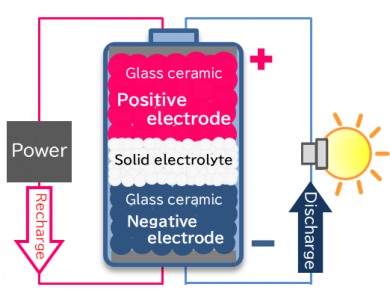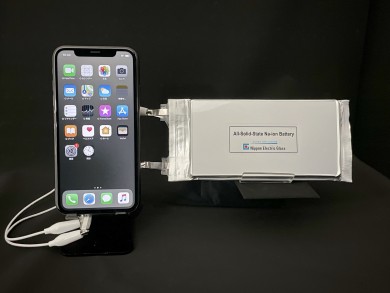Nov 18, 2021
Nippon Electric Glass Co., Ltd. (Head Office: Otsu, Shiga, Japan, President: Motoharu Matsumoto) developed a new negative electrode material using glass ceramic for the all-solid-state Na-ion secondary battery, and became the first to successfully operate an all-oxide all-solid-state Na-ion secondary battery integrated with a glass ceramic positive electrode and a solid electrolyte.
The proposed all-solid-state Na-ion secondary battery has an output voltage of 3V; in addition, it possesses great application prospect and its performance is comparable to that of the existing lithium-ion rechargeable batteries.
The proposed all-solid-state Na-ion secondary battery utilizes abundant metals, such as sodium and iron materials, and does not require any rare metals, such as lithium, cobalt, and nickel, which are generally difficult to source for applications in conventional battery technologies. In addition, since the battery comprises a stable oxide material, it does not ignite nor generate harmful gas, even when pierced by a nail or knife.
We aim to achieve a carbon-free society by commercializing the applications of all-oxide all-solid-state Na-ion secondary battery as it uses affordable resources and is very safe when operated.
The results of this development will be reported at the 62nd Battery Symposium in Japan (at Pacifico Yokohama), which will be held from November 30th.

All-Solid-State Sodium (Na) Ion
Secondary
Battery Structure

Developed battery and its operation
《Features》
1.High safety
The battery material consists entirely of inorganic oxides,
thereby overcoming limitations such as ignition or
generation of toxic substances during use and production.
2.Excellent battery performance
・The battery can be operated at low temperatures owing to the
softening fluidity of the glass used to integrate the
positive and negative electrodes with the solid electrolyte
and to improve the ionic conductivity.
・The solid electrolyte has enhanced cycle characteristics with
minor deterioration due to the ion transfer.
・By developing high-potential active materials with simple
structures, it is possible to manufacture batteries with high
energy densities.
3.Abundant resources
The battery uses sodium that has abundant resources, and thus,
there are no concerns related to supply compared to those
associated with resources such as lithium and cobalt.


